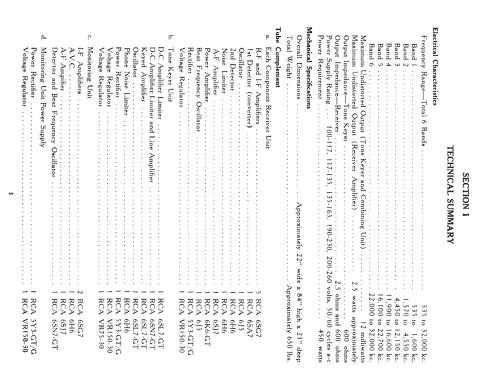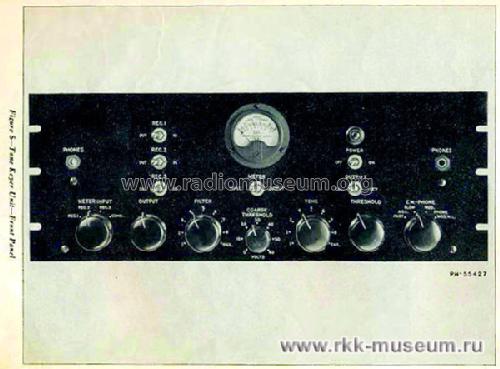- Country
- United States of America (USA)
- Manufacturer / Brand
- RCA (RCA Victor Co. Inc.); New York (NY)
- Year
- 1943–1950
- Category
- Commercial Receiver (may include amateur bands)
- Radiomuseum.org ID
- 167570
-
- alternative name: RCA Manufacturing || Victor Talking Machine
Click on the schematic thumbnail to request the schematic as a free document.
- Number of Tubes
- 51
- Main principle
- Superhet with RF-stage; ZF/IF 455 kHz; 2 AF stage(s)
- Wave bands
- Wave Bands given in the notes.
- Power type and voltage
- Alternating Current supply (AC) / 110, 125, 150, 210, 240 Volt
- Loudspeaker
- -Loudspeaker incorporated, but system not known.
- Power out
- 2.5 W (unknown quality)
- Material
- Metal case
- from Radiomuseum.org
- Model: DR-89 - RCA RCA Victor Co. Inc.; New
- Shape
- Boatanchor (heavy military or commercial set >20 kg).
- Dimensions (WHD)
- 559 x 2134 x 533 mm / 22 x 84 x 21 inch
- Notes
- Diversity Reception Equipment consisting of three "Component Receivers" (type AR-88-F), Tone Keyer Unit and Monitoring Unit with its own power supply. Curiously enough, RCA has called this set just "Diversity Communication Receiver, Type DR-89" (a receiver containing three other separate receivers…). The Component Receiver, AR-88-F, is described separately on this site. All radio frequency features of DR-89 were the same as those of AR-88-F, i.e. continuous coverage of 535 kHz to 32 MHz in 6 switched bands, and IF 455 kHz with crystal filter. On top of AR-88-F receivers, vacuum tubes were used in Tone Keyer Unit and in Monitoring Unit with power supply. Every tube type was mentioned only once in the "Valves/Tubes" list above. Many DR-89 sets have been supplied in 1942-1945 to the UK and the USSR by Lend-Lease Act. Around 1945, the DR-89 was adopted by US Signal Corps and got its military designation OA-58/FRC.
- Net weight (2.2 lb = 1 kg)
- 295 kg / 649 lb 12.5 oz (649.78 lb)
- Literature/Schematics (1)
- IB-25955-1. Diversity Communication Receiver, Type DR-89. Instructions. RCA, Camden, NJ, USA.
- Author
- Model page created by Valery Gromov. See "Data change" for further contributors.
- Other Models
-
Here you find 5135 models, 3239 with images and 4175 with schematics for wireless sets etc. In French: TSF for Télégraphie sans fil.
All listed radios etc. from RCA (RCA Victor Co. Inc.); New York (NY)












